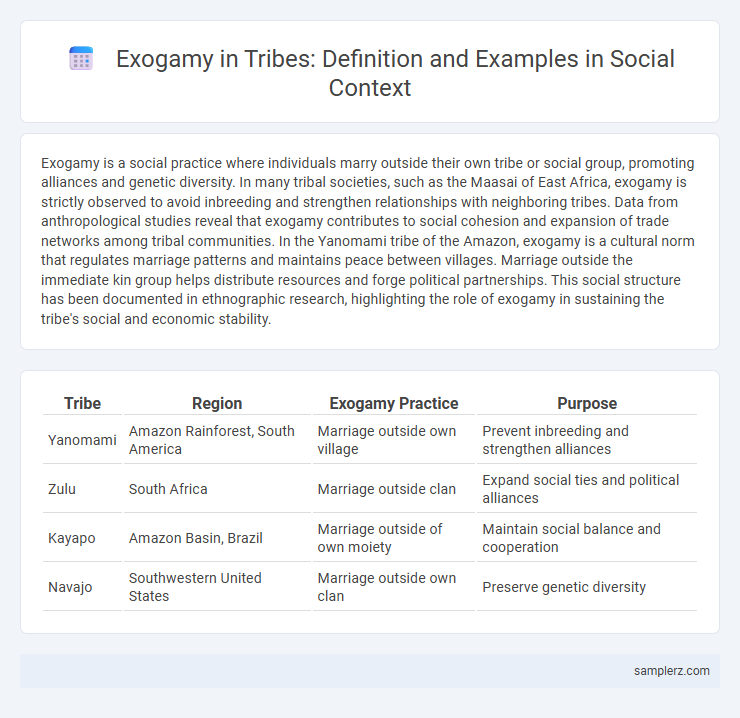Exogamy is a social practice where individuals marry outside their own tribe or social group, promoting alliances and genetic diversity. In many tribal societies, such as the Maasai of East Africa, exogamy is strictly observed to avoid inbreeding and strengthen relationships with neighboring tribes. Data from anthropological studies reveal that exogamy contributes to social cohesion and expansion of trade networks among tribal communities. In the Yanomami tribe of the Amazon, exogamy is a cultural norm that regulates marriage patterns and maintains peace between villages. Marriage outside the immediate kin group helps distribute resources and forge political partnerships. This social structure has been documented in ethnographic research, highlighting the role of exogamy in sustaining the tribe's social and economic stability.
Table of Comparison
| Tribe | Region | Exogamy Practice | Purpose |
|---|---|---|---|
| Yanomami | Amazon Rainforest, South America | Marriage outside own village | Prevent inbreeding and strengthen alliances |
| Zulu | South Africa | Marriage outside clan | Expand social ties and political alliances |
| Kayapo | Amazon Basin, Brazil | Marriage outside of own moiety | Maintain social balance and cooperation |
| Navajo | Southwestern United States | Marriage outside own clan | Preserve genetic diversity |
Understanding Exogamy: Definition and Social Importance
Exogamy refers to the social practice of marrying outside one's immediate social group, clan, or tribe, promoting genetic diversity and social alliances. In many indigenous tribes, such as the Maasai of East Africa, exogamy strengthens inter-tribal relationships and fosters cooperation. This practice prevents inbreeding and builds broader social networks, which are crucial for community survival and resource sharing.
Historical Roots of Exogamy in Tribal Societies
Exogamy in tribal societies historically served to forge alliances and promote genetic diversity by encouraging marriage outside one's immediate clan or tribe. Tribes such as the Australian Aboriginal groups practiced strict exogamous rules that prevented unions within the same moiety or kinship circle. This system helped maintain social cohesion and expanded networks for trade, warfare, and cultural exchange between different tribal communities.
Case Study: The Nuer Tribe’s Exogamous Marriage Practices
The Nuer tribe of South Sudan practices exogamy by requiring members to marry outside their own patrilineal clan, reinforcing social alliances across different clans. This practice prevents inbreeding and promotes wider kinship networks that support communal cooperation and resource sharing. Anthropological studies highlight how Nuer exogamous marriages strengthen social cohesion and political stability within the tribe.
Exogamy among the Gond Tribe of Central India
Exogamy among the Gond Tribe of Central India mandates marrying outside one's clan to prevent inbreeding and strengthen social alliances. This practice fosters inter-clan relationships, enhancing communal unity and resource sharing. The Gond exogamous system reflects deep cultural values emphasizing kinship diversity and social cohesion.
Cross-Clan Marriages in the Khasi Tribe of Meghalaya
Cross-clan marriages in the Khasi tribe of Meghalaya exemplify exogamy, where individuals marry outside their own clan to foster social cohesion and prevent inbreeding. The Khasi practice matrilineal descent, emphasizing descent through the mother's lineage, making clan boundaries critical for marital alliances. This custom strengthens inter-clan relationships and preserves cultural identity by promoting diverse kinship ties within the community.
Exogamous Alliances in the Australian Aboriginal Communities
Exogamous alliances in Australian Aboriginal communities are characterized by strict kinship rules that require individuals to marry outside their own clan or moiety, fostering social cohesion and resource exchange between distinct groups. These marital practices prevent inbreeding and establish complex networks of reciprocal relationships critical for cultural continuity and land stewardship. Such alliances also facilitate intergroup cooperation, as marriage ties often underpin ceremonial partnerships and collective responsibilities across vast territories.
The Role of Totemic Exogamy among Native American Tribes
Totemic exogamy among Native American tribes functions as a crucial social mechanism that mandates marriage outside one's own clan or totem group, fostering alliances and preventing incestuous relationships. This practice reinforces inter-clan cooperation and cultural identity by linking distinct totemic groups through marital ties. Such exogamous rules contribute to social cohesion and the transmission of ancestral knowledge across tribes.
Social Cohesion and Exogamy in the Maasai Tribe
The Maasai tribe practices exogamy by encouraging marriage outside of their clan, fostering social cohesion across diverse groups. This system strengthens alliances and resource sharing among different Maasai sections, promoting cultural unity. Exogamous marriages enhance community integration, reducing conflict and supporting social stability.
Benefits of Exogamy in Tribal Social Structure
Exogamy in tribal social structures fosters genetic diversity by encouraging marriage outside one's clan or village, reducing the risks of inherited diseases. This practice strengthens inter-tribal alliances and cooperation, promoting social cohesion and resource sharing among different groups. Exogamous marriages also enhance cultural exchange, enriching traditions and broadening the tribe's collective knowledge base.
Challenges and Changes: Modern Influences on Tribal Exogamy
Tribal exogamy faces significant challenges as modernization introduces diverse cultural norms and legal frameworks that often conflict with traditional practices. Increased migration, education, and exposure to global media alter marriage choices, leading to more inter-tribal unions and shifting social structures. These changes strain tribal cohesion and identity, compelling communities to adapt customs while negotiating preservation and integration in contemporary society.

example of exogamy in tribe Infographic
 samplerz.com
samplerz.com